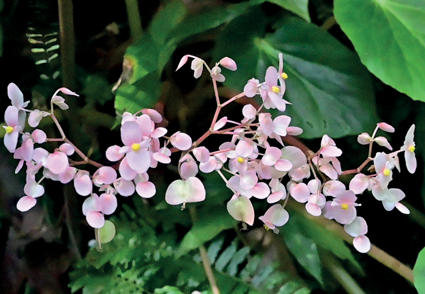Abstract
Begonia tanauanensis is a newly described endemic species in B. sect. Baryandra from Tanauan City, Batangas, southern Luzon, Philippines. Morphological data shows this species resembles B. chingipengii, a species from eastern Luzon as both species have light pink flowers, fleshy green lamina, and boat-shaped bracts. However, B. tanauanensis does not have the prominent white midrib and veins in the adaxial leaf surface, ciliate hairs on leaf margin, strongly keeled stipules and tomentose hairs on the abaxial leaf surface and petioles of B. chingipengii. The plants were observed to have a restricted and severely fragmented distribution. Unfortunately, these observed populations are also affected by human activities and threat of volcanic activity of the nearby Taal Volcano. Because of these threats, we provisionally assess the species as “Critically Endangered” (CR) following the IUCN Red List Categories and Criteria.
References
- Amoroso, V.B., Lamparas, R.J.V., Lagunday, N.E., Dapar, M.L.G. & Rubite, R.R. (2023) Begonia fritschiana (Begoniaceae, Begonia section Baryandra), a new species from Quezon, Bukidnon, Philippines. Phytotaxa 587 (1): 39–46. https://doi.org/10.11646/phytotaxa.587.1.5
- Ang, Y.P., Collantes, J.P.R., Mansibang, J., Cruz, C.J.P.D., Aumentado, J.A.M., Bimeda, S.B. & Bustamante, R.A.A. (2023) Two new species of Begonia (Begoniaceae) from Aurora Memorial National Park, Luzon Island, Philippines. Phytotaxa 609 (4): 253–264. https://doi.org/10.11646/phytotaxa.609.4.1
- Blasco, F.A., Tandang, D.N., Alejandro, G.J.D., Bucay, M.A.C., Cortes, J.C. & Rubite, R.R. (2023) Begonia noraaunorae (section Petermannia, Begoniaceae) a new species endemic to Surigao del Sur, Mindanao Island, Philippines. Phytotaxa 620 (2): 193–197. https://doi.org/10.11646/phytotaxa.620.2.8
- Calaramo, M.A., Rubite, R.R., Pugal, C.M. & Lin, C.W. (2019) New species of Begonia section Baryandra (Begoniaceae) from northwestern Luzon, Philippines. Phytotaxa 407 (1): 36–42. https://doi.org/10.11646/phytotaxa.407.1.6
- Candolle, A.P. de (1859) Mémoire sur la famille des Bégoniacées. Annales des Sciences Naturelles, Botanique, sér 4, 11 : 128–134.
- Delos Angeles, M.D.D., Rubite, R.R., Chung, K.F., Buot Jr, I.E. & Tandang, D.N. (2022) Begonia normaaguilariae (section Baryandra, Begoniaceae), a new species from the limestone forests of Samar Island, Philippines. Phytotaxa 541 (1): 49–56. https://doi.org/10.11646/phytotaxa.541.1.4
- Delos Reyes, P.J., Bornas, A.V., Dominey-Hawes, D., Pidlaoan, A.C., Magill, C.R. & Solidum, Jr., R.U. (2018) A synthesis and review of historical eruptions at Taal Volcano, Southern Luzon, Philippines. Earth-Science Reviews 177: 568–588. https://doi.org/10.1016/j.earscirev.2017.11.014
- Hughes, M., Rubite, R.R., Blanc, P., Chung, K.F. & Peng, C.-I. (2015) The Miocene to Pleistocene colonization of the Philippine archipelago by Begonia sect. Baryandra (Begoniaceae). American Journal of Botany 102: 695–706. https://doi.org/10.3732/ajb.1400428
- Hughes, M., Peng, C.-I, Lin, C.W., Rubite, R.R., Blanc, P. & Chung, K.F. (2018) Chloroplast and nuclear DNA exchanges among Begonia sect. Baryandra species (Begoniaceae) from Palawan Island, Philippines, and descriptions of five new species. PloS One 13 (5): e0194877. https://doi.org/10.1371/journal.pone.0194877
- IUCN Standards and Petitions Subcommittee (2022) Guidelines for using the IUCN Red List Categories and Criteria. Version 15.1. Available from: https://nc.iucnredlist.org/redlist/content/attachment_files/RedListGuidelines.pdf (Accessed: 4 March 2024).
- Mazo, K.R.F., Salatan, N.L. & Rubite, R.R. (2023) A new species of Begonia section Baryandra from Zamboanga Peninsula, Southwestern Philippines. Webbia Journal of Plant Taxonomy and Geography 78 (2): 87–92. https://doi: 10.36253/jopt-15028
- Merrill, E.D. (1915) Plantae Wenzelianae III. Philippine Journal of Science, section C, Botany 10 (4): 265–285.
- Merrill, E.D. (1912 [1911]) The Philippine species of Begonia. Philippine Journal of Science, section C, Botany 6 (6): 369–406.
- Pelser, P.B., Barcelona, J.F. & Nickrent, D.L. (Eds.) (2011 onwards) Co’s digital flora of the Philippines. Available from: http://www.philippineplants.org (Accessed: 15 May 2023).
- Rubite, R.R., Peng, C.I., Chung, K.F., Lin, C.W., Evangelista, L.T., Tandang, D.N., Callado, J.R.C. & Hughes, M. (2018) Three new species of Begonia (section Baryandra, Begoniaceae) from Luzon Island, the Philippines. Phytotaxa 347 (3): 201–212. https://doi.org/10.11646/phytotaxa.347.3.1
- Rubite, R.R., Hughes, M., Alejandro, G.J.D. & Peng, C.I. (2013) Recircumscription of Begonia sect. Baryandra (Begoniaceae): evidence from molecular data. Botanical Studies 54: 38. https://doi.org/10.1186/1999-3110-54-38
- WFO (2023) Lansium domesticum Corrêa. Published on the Internet; http://www.worldfloraonline.org/taxon/wfo-0000443574 (Accessed: 26 November 2023).


